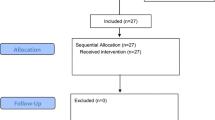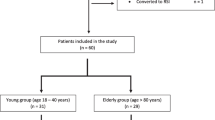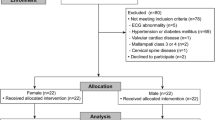Abstract
Background
Remifentanil used in combination with propofol provides adequate conditions for tracheal intubation without muscle relaxants. Delivery of the optimal dose is important to prevent poor intubation conditions and drug-related complications. No previous study has investigated the use of a remifentanil–propofol combination in elderly patients.
Objective
The aim of the present study was to determine the dose of remifentanil necessary for rapid tracheal intubation without the use of muscle relaxants in elderly patients.
Methods
A total of 24 patients >65 years of age with American Society of Anesthesiologists status I–II who were scheduled to undergo elective surgery under general anaesthesia were enrolled. After premedication with glycopyrrolate and midazolam, anaesthesia was induced with 1 mg/kg propofol, and a blinded dose of remifentanil was then infused over 30 s after confirming the patient’s loss of consciousness. The remifentanil dose was determined using Dixon’s up-and-down method, starting at 2 µg/kg. Intubation was performed 60 s after the loss of consciousness. Intubation conditions were assessed with the Stockholm score and an assessment of excellent or good condition was regarded as being clinically acceptable. The effective dose needed for acceptable intubation conditions in 50 % of the subjects (ED50) was determined by Dixon’s up-and-down method, and the ED50 and the effective dose needed for acceptable intubation conditions in 95 % of the subjects (ED95) with 95 % confidence intervals (CIs) were determined by probit analysis.
Results
In total, 24 patients were recruited and the median age (interquartile range) was 70 (66–74) years. The ED50 of remifentanil for tracheal intubation was 1.15 (standard deviation 0.13) µg/kg. The ED50 and ED95 of remifentanil obtained from the probit analyses were 1.16 (95 % CI 1.01, 1.29) µg/kg and 1.39 (95 % CI 1.27, 2.13) µg/kg, respectively. Blood pressure and heart rate decreased significantly after propofol and remifentanil administration, but were within 30 % of baseline values.
Conclusions
Combined with 1 mg/kg propofol, 1.39 (95 % CI 1.27, 2.13) µg/kg remifentanil resulted in acceptable intubation conditions within 60 s in 95 % of elderly patients without major complications.



Similar content being viewed by others
References
Stevens JB, Wheatley L. Tracheal intubation in ambulatory surgery patients: using remifentanil and propofol without muscle relaxants. Anesth Analg. 1998;86(1):45–9.
Klemola UM, Mennander S, Saarnivaara L. Tracheal intubation without the use of muscle relaxants: remifentanil or alfentanil in combination with propofol. Acta Anaesthesiol Scand. 2000;44(4):465–9.
McNeil IA, Culbert B, Russell I. Comparison of intubating conditions following propofol and succinylcholine with propofol and remifentanil 2 micrograms kg-1 or 4 micrograms kg-1. Br J Anaesth. 2000;85(4):623–5.
Mencke T, Echternach M, Kleinschmidt S, et al. Laryngeal morbidity and quality of tracheal intubation: a randomized controlled trial. Anesthesiology. 2003;98(5):1049–56.
Fuchs-Buder T, Claudius C, Skovgaard LT, et al. Good clinical research practice in pharmacodynamic studies of neuromuscular blocking agents II: the Stockholm revision. Acta Anaesthesiol Scand. 2007;51(7):789–808.
Dixon WJ. Staircase bioassay: the up-and-down method. Neurosci Biobehav Rev. 1991;15(1):47–50.
Woods AW, Allam S. Tracheal intubation without the use of neuromuscular blocking agents. Br J Anaesth. 2005;94(2):150–8.
McKeating K, Bali IM, Dundee JW. The effects of thiopentone and propofol on upper airway integrity. Anaesthesia. 1988;43(8):638–40.
Hall AP, Thompson JP, Leslie NA, et al. Comparison of different doses of remifentanil on the cardiovascular response to laryngoscopy and tracheal intubation. Br J Anaesth. 2000;84(1):100–2.
Bouvet L, Stoian A, Rimmele T, et al. Optimal remifentanil dosage for providing excellent intubating conditions when co-administered with a single standard dose of propofol. Anaesthesia. 2009;64(7):719–26.
Bouvet L, Stoian A, Jacquot-Laperriere S, et al. Laryngeal injuries and intubating conditions with or without muscular relaxation: an equivalence study. Can J Anaesth. 2008;55(10):674–84.
Baillard C, Adnet F, Borron SW, et al. Tracheal intubation in routine practice with and without muscular relaxation: an observational study. Eur J Anaesthesiol. 2005;22(9):672–7.
Shafer SL. The pharmacology of anesthetic drugs in elderly patients. Anesthesiol Clin N Am. 2000;18(1):1–29.
Schnider TW, Minto CF, Shafer SL, et al. The influence of age on propofol pharmacodynamics. Anesthesiology. 1999;90(6):1502–16.
Minto CF, Schnider TW, Shafer SL. Pharmacokinetics and pharmacodynamics of remifentanil. II. Model application. Anesthesiology. 1997;86(1):24–33.
Combes X, Andriamifidy L, Dufresne E, et al. Comparison of two induction regimens using or not using muscle relaxant: impact on postoperative upper airway discomfort. Br J Anaesth. 2007;99(2):276–81.
Acknowledgments
The present study was not funded or sponsored by any organization. All co-authors made substantial contributions to the work and have no conflicts of interest to report.
Author information
Authors and Affiliations
Corresponding author
Rights and permissions
About this article
Cite this article
Goo, EK., Oh, AY., Cho, SJ. et al. Optimal Remifentanil Dosage for Intubation without Muscle Relaxants in Elderly Patients. Drugs Aging 29, 905–909 (2012). https://doi.org/10.1007/s40266-012-0019-y
Published:
Issue Date:
DOI: https://doi.org/10.1007/s40266-012-0019-y




